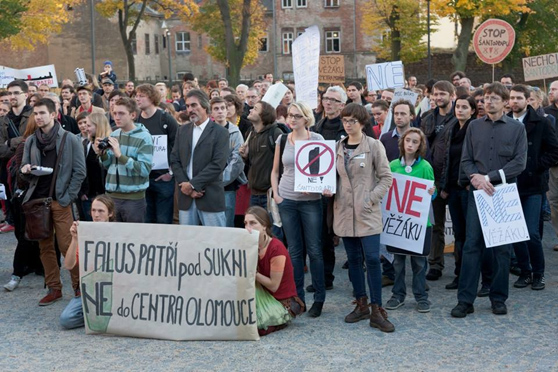
Citizens against Šantovka Tower: The Olomouc Call
 |
There is talk concerning the illegality of the executive component of heritage protection, the privatization of the skyline at the expense of public interest protection, and possible failures of state administration. In the eyes of supporters, the residential tower represents the development of the city, a symbol of its dreamed prosperity. In the eyes of opponents, it becomes a caricature of such development, similar to what the previous two "skyscrapers," which stand outside the protective zone of the heritage reserve, have achieved.
The most well-known tourist guide, Lonely Planet, recently labeled Olomouc as the most beautiful city in the Czech Republic. According to them, this "hidden gem of Europe" has "architectural charm without great chaos." Does a tourist—sent here preferentially by a prestigious guide—want a glass tower to form a backdrop to the unique atmosphere of the compact historical core, evoking rather the practices of predatory developers of Eastern European ilk? This could easily happen, as the tower could significantly assert itself visually from the very center of Olomouc, from the Lower Square.
The investor has not yet initiated the zoning procedure regarding the construction, but they have already overcome one significant obstacle. To the great indignation of experts in architecture and heritage care, they received the green light from the city heritage protectors. The legitimacy of their stance will now be examined by the Regional Office.
The expert public and citizens are not passively observing. Recently, a conclusion from the Scientific Council of the General Director of the National Heritage Institute was published. Twenty members expressed their unanimous negative stance on the plan. After two past petition activities (900 and 700 signatures) and a public gathering attended by over 400 people on October 22, 2013, representatives of the initiative Citizens Against ŠantovkaTower came forward with the so-called Olomouc Challenge.
The simple, concentrated title corresponds to the seriousness of its content. Behind the specific demands in the STW case lies an appeal from the public to elected representatives, who should prioritize defending their interests in such fundamental matters. The private residential building project has no participation from the city. It should arise in an area that could provide space for a complete urban district in accordance with current trends in urbanism and with regard to the valuable historical fabric of the city in its immediate vicinity. The investor plans to sell views of the unique historical panorama, which they themselves are damaging. The city receives nothing in return.
Martina Mertová
> www.krasnaolomouc.cz
> www.petice24.com/olomoucka_vyzva
The English translation is powered by AI tool. Switch to Czech to view the original text source.
0 comments
add comment
Related articles
0
14.02.2020 | Olomouc City Hall currently has no information about the ombudsman's lawsuit
0
14.02.2020 | The ombudswoman is suing Olomouc over the construction of Šantovka Tower
0
25.12.2019 | Investor Šantovky Tower has appealed against the decision of the magistrate
0
11.07.2019 | The opposition demands a review of the zoning decision for Šantovka Tower
0
14.06.2019 | The Olomouc Šantovka Tower has obtained a land-use decision
0
08.09.2016 | The Heritage Inspection is reviewing the evaluation of the Šantovka Tower building
0
23.06.2016 | Building closure on the lands near the planned Šantovka Tower is experiencing further delays
0
06.05.2016 | Opposition ProOlomouc requested the region for a building closure in Olomouc
0
22.03.2016 | The Constitutional Court rejected the company's complaint regarding the high-rise building in Olomouc
0
16.03.2016 | Olomouc will have a legal analysis prepared due to the construction ban
0
11.01.2016 | Olomouc has prepared a construction closure at the site for Šantovka Tower
0
20.11.2015 | Olomouc wants a building freeze on the land for Šantovka Tower
0
17.11.2015 | Olomouc may introduce a construction moratorium in the amendment of the zoning plan
1
14.10.2015 | In Olomouc, height limits will cease to apply from January
0
27.07.2015 | Developer failed with the cassation complaint regarding Šantovka Tower
0
16.04.2015 | The company failed in the dispute with NPÚ regarding the Olomouc high-rise building
0
04.03.2015 | Olomouc wants to modify the zoning plan due to the court's ruling
0
03.03.2015 | The regional office revoked the consent of the Olomouc city hall for Šantovka Tower
2
25.02.2015 | The court annulled the height regulation of new buildings in the center of Olomouc
1
03.11.2014 | Investor Šantovka Tower is suing Olomouc due to the zoning plan
0
30.06.2014 | In Olomouc, an exhibition of photographers opened, mapping the city from above
1
28.06.2014 | Šantovka Tower brought discord between the university and the Olomouc city hall
0
20.02.2014 | In the Mila area near the center of Olomouc, final demolition has begun.
0
27.01.2014 | The regional authority revoked the consent of the Olomouc city council for the Šantovka Tower
0
22.01.2014 | Expert: The Šantovka Tower building will be visible even from the center of Olomouc
1
30.11.2013 | The Czech branch of ICOMOS does not agree with the Šantovka high-rise building
1
22.11.2013 | MMR abolished the regulation of the construction of high-rise buildings in the Olomouc region
2
21.11.2013 | Investor of Šantovky Tower accused the heritage protectors of exceeding their powers











